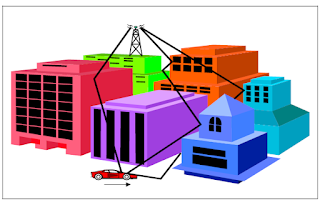Many radio propagation effects such as reflections can attenuate the transmitted radio signal
2. Fast fading (Rayleigh fading)
This occurs when the propagation wave reflects on an object, which is large compared to the wavelength, for example, the surface of the earth, buildings, walls, etc. This phenomenon is called multipath propagation and it has several effects, these are:
- Rapid changes in signal strength over a small area or time interval
- Random frequency modulation due to varying Doppler shifts on different multipath signals.
- Time dispersion caused by multipath propagation delays
Previous symbol leaks into current symbol due to the different path delays
+ When the amount of ISI exceeds a certain level (~10%) bit errors occur
+ Can be reduced with equalizers, rake receivers or the use of OFDM
Visit our Facebook Page
Multipath Propagation gives rise to:
1. InterSymbol Interference (ISI)2. Fast fading (Rayleigh fading)
- Rapid changes in signal strength over a small area or time interval
- Random frequency modulation due to varying Doppler shifts on different multipath signals.
- Time dispersion caused by multipath propagation delays
Previous symbol leaks into current symbol due to the different path delays
+ When the amount of ISI exceeds a certain level (~10%) bit errors occur
+ Can be reduced with equalizers, rake receivers or the use of OFDM
Multipath propagation yields signal paths of different lengths with different times of arrival at the receiver. Typical values of time delays (μs) are 0.2 in Open environment, 0.5 Suburban and 3 in
Urban.
This results in a varying received signal power as illustrated
This attenuation can result in bit errors that occur in consecutive blocks of data (burst errors). As a result the decoder fails to recover such errors.
Interleaving
The solution to overcome the problem with burst errors is to use a block interleaving technique
A radio channel produces bursty errors. Because continuous codes are most effective against random errors, interleaving is used to randomize the bursty errors. The interleaving scheme can be either block interleaving or convolutional interleaving. Typically, block interleaving is used in cellular applications. The first step of interleaving is determined by the delay requirements of the service.
Visit our Facebook Page
SCRAMBLING
In LTE, a frequency reuse of 1 will typically be used. This means that all cells use the same frequency band(s). For UEs close to the cell border, this will lead to massive interference in both UL and DL.
In order to reduce this inter cell interference, a cell specific bitlevel scrambling is applied for all transmissions in both UL and DL.
Other solutions for mitigating the inter-cell interference includes e.g. Inter Cell Interference Co ordination (ICIC). ICIC co-ordinates the radio resource allocations (scheduling) between neighboring
cells that experience problems.
Cell specific bit-level scrambling used in LTE for all datastreams in UL and DL
+ used in order to achieve interference randomization between cells
+ No frequency planning (freq reuse 1)
– massive inter-cell interference mitigated by scrambling and interference co-ordination techniques (e.g. ICIC)
+ Common scrambling used for cells in broadcast/multicast service transmissions (MBMS)




